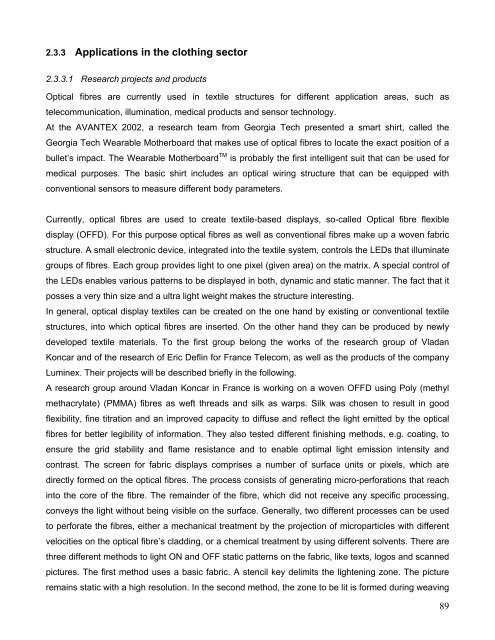Clevertex - Grado Zero Espace Srl
Clevertex - Grado Zero Espace Srl
Clevertex - Grado Zero Espace Srl
You also want an ePaper? Increase the reach of your titles
YUMPU automatically turns print PDFs into web optimized ePapers that Google loves.
2.3.3 Applications in the clothing sector<br />
2.3.3.1 Research projects and products<br />
Optical fibres are currently used in textile structures for different application areas, such as<br />
telecommunication, illumination, medical products and sensor technology.<br />
At the AVANTEX 2002, a research team from Georgia Tech presented a smart shirt, called the<br />
Georgia Tech Wearable Motherboard that makes use of optical fibres to locate the exact position of a<br />
bullet’s impact. The Wearable Motherboard TM is probably the first intelligent suit that can be used for<br />
medical purposes. The basic shirt includes an optical wiring structure that can be equipped with<br />
conventional sensors to measure different body parameters.<br />
Currently, optical fibres are used to create textile-based displays, so-called Optical fibre flexible<br />
display (OFFD). For this purpose optical fibres as well as conventional fibres make up a woven fabric<br />
structure. A small electronic device, integrated into the textile system, controls the LEDs that illuminate<br />
groups of fibres. Each group provides light to one pixel (given area) on the matrix. A special control of<br />
the LEDs enables various patterns to be displayed in both, dynamic and static manner. The fact that it<br />
posses a very thin size and a ultra light weight makes the structure interesting.<br />
In general, optical display textiles can be created on the one hand by existing or conventional textile<br />
structures, into which optical fibres are inserted. On the other hand they can be produced by newly<br />
developed textile materials. To the first group belong the works of the research group of Vladan<br />
Koncar and of the research of Eric Deflin for France Telecom, as well as the products of the company<br />
Luminex. Their projects will be described briefly in the following.<br />
A research group around Vladan Koncar in France is working on a woven OFFD using Poly (methyl<br />
methacrylate) (PMMA) fibres as weft threads and silk as warps. Silk was chosen to result in good<br />
flexibility, fine titration and an improved capacity to diffuse and reflect the light emitted by the optical<br />
fibres for better legibility of information. They also tested different finishing methods, e.g. coating, to<br />
ensure the grid stability and flame resistance and to enable optimal light emission intensity and<br />
contrast. The screen for fabric displays comprises a number of surface units or pixels, which are<br />
directly formed on the optical fibres. The process consists of generating micro-perforations that reach<br />
into the core of the fibre. The remainder of the fibre, which did not receive any specific processing,<br />
conveys the light without being visible on the surface. Generally, two different processes can be used<br />
to perforate the fibres, either a mechanical treatment by the projection of microparticles with different<br />
velocities on the optical fibre’s cladding, or a chemical treatment by using different solvents. There are<br />
three different methods to light ON and OFF static patterns on the fabric, like texts, logos and scanned<br />
pictures. The first method uses a basic fabric. A stencil key delimits the lightening zone. The picture<br />
remains static with a high resolution. In the second method, the zone to be lit is formed during weaving<br />
89

















